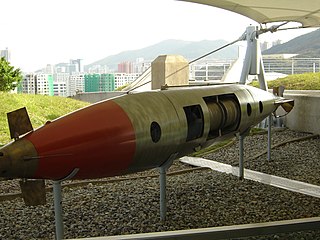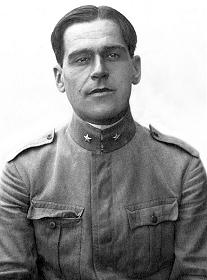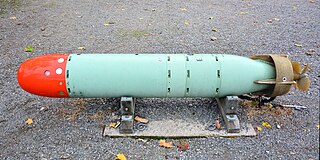 W
WAcoustic homing is a system which uses the acoustic signature (sound) of a target to guide a moving object, such as a torpedo. Acoustic homing can be either Passive or Active in nature. Using Passive, the system is designed to move either toward or away from a sound, and may also be designed to move only toward certain types of sounds to the exclusion of others, while Active is a true Sonar. The system emits a sound pulse that reflects off objects and then back to the system, where the system processes the echos to determine the proper response.
 W
WAn acoustic torpedo is a torpedo that aims itself by listening for characteristic sounds of its target or by searching for it using sonar. Acoustic torpedoes are usually designed for medium-range use, and often fired from a submarine.
 W
WHuman torpedoes or manned torpedoes are a type of diver propulsion vehicle on which the diver rides, generally in a seated position behind a fairing. They were used as secret naval weapons in World War II. The basic concept is still in use.
 W
WA spar torpedo is a weapon consisting of a bomb placed at the end of a long pole, or spar, and attached to a boat. The weapon is used by running the end of the spar into the enemy ship. Spar torpedoes were often equipped with a barbed spear at the end, so it would stick to wooden hulls. A fuse could then be used to detonate it.
 W
WThe Brennan torpedo was a torpedo patented by Irish-born Australian inventor Louis Brennan in 1877. It was propelled by two contra-rotating propellors that were spun by rapidly pulling out wires from drums wound inside the torpedo. Differential speed on the wires connected to the shore station allowed the torpedo to be guided to its target, up to 2,000 yards (1,800 m) away, at speeds of up to 27 knots (31 mph).
 W
WThe Drzewiecki drop collar was an external torpedo launching system most commonly used by the French and Imperial Russian Navies in the first two decades of the 20th century. It was designed by Stefan Drzewiecki, a Polish engineer and inventor.
 W
WThe Mark 23 torpedo was a submarine-launched anti-surface ship torpedo designed and built by the Naval Torpedo Station for the United States Navy in World War II. It was essentially a Mark 14 torpedo, modified via the removal of its low-speed, long-range setting, leaving the high-speed, short-range feature in place.
 W
WThe Mark 24 mine is an air-dropped anti-submarine warfare weapon (ASW) incorporating passive acoustic homing system and torpedo integration. It was used by the United States, the British and Canadian forces during the Second World War and entered service in March 1943 and remained in use with the US Navy until 1948. Approximately 4,000 torpedoes were produced, with 340 ultimately being deployed during the war. 204 torpedoes were launched against submarine targets, with 37 Axis submarines being sunk and a further 18 damaged. The deceptive name of "Mark 24 Mine" was deliberately chosen for security purposes, to conceal the true nature of the weapon.
 W
WThe Mark 32 Surface Vessel Torpedo Tubes system is a torpedo launching system designed for the United States Navy. The Mark 32 has been the standard anti-submarine torpedo launching system aboard United States Navy surface vessels since its introduction in 1960, and is in use aboard the warships of several other navies.
 W
WThe Mark 32 torpedo was the first active acoustic antisubmarine homing torpedo in United States Navy service. The Mark 32 was withdrawn from service use with the introduction of the Mark 43 torpedo.
 W
WRaffaele Rossetti was an Italian engineer and military naval officer who sank the main battleship of the Austro-Hungarian Empire at the end of World War I. He was also a politician of the Italian Republican Party.
 W
WOtto Fuel II is a monopropellant used to drive torpedoes and other weapon systems. It is not related to the Otto cycle.
 W
WPendulum-and-hydrostat control is a control mechanism developed originally for depth control of the Whitehead torpedo. It is an early example of what is now known as proportional and derivative control
 W
WGiovanni (Ivan) Biagio Luppis Freiherr von Rammer, sometimes also known by the Croatian name of Vukić, was an officer of the Austro-Hungarian Navy who headed a commission to develop the first prototypes of the self-propelled torpedo.
 W
WThe Siluro San Bartolomeo was an Italian Human Torpedo designed during World War II, used by the Decima Flottiglia MAS for commando style operations. When using the Siluro a Lenta Corsa Maiale Human Torpedo had noticed some limitations, demonstrating the need for an updated version. The project was managed and developed by the engineer of the Genio Naval, Mayor Mario Masciulli, with the help of Captain G.N Travaglino and engineer Guido Cattaneo. The improvement in the materials available for the assembly and parallel new technologies led to a far superior product to the point of not being able to identify and as an outgrowth of the "Siluro a Lenta Corsa" SLC Maiale.
 W
WThe Torped 45 is a lightweight torpedo intended for ASW and surface targets, providing multiple-target active/passive homing combined with wire guidance. It is designed and manufactured by Saab Dynamics. It was designed for the Swedish Navy, based on the experience gathered from the well proven 43-series of torpedoes.
 W
WTorped 613 is a heavyweight torpedo still in use by the Swedish Navy. It is wire-guided and has a passive sonar sensor, which sends back information through the wire. The torpedo was developed in the 1970s as a cooperation project between Denmark, Norway and Sweden. Testing was done during the period 1981-1983.
 W
WTorpedo trials craft' are primarily naval auxiliaries used by navies for the development of new naval torpedoes and during practise firings. These craft are designed to track and monitor the torpedo and to be able to locate and retrieve the spent torpedo for analysis, and refurbishment for reuse. Torpedo trials craft had their greatest use during the years around World War II when the torpedo was the primary anti-ship weapon of submarines, destroyers and naval aircraft.
 W
WA torpedo tube is a cylinder-shaped device for launching torpedoes.
 W
WA modern torpedo is an underwater ranged weapon launched above or below the water surface, self-propelled towards a target, and with an explosive warhead designed to detonate either on contact with or in proximity to the target. Historically, such a device was called an automotive, automobile, locomotive or fish torpedo; colloquially a fish. The term torpedo originally applied to a variety of devices, most of which would today be called mines. From about 1900, torpedo has been used strictly to designate a self-propelled underwater explosive device.
 W
WValfajr is a modern homing torpedo system designed, developed, and tested by Iran's Ministry of Defence.
 W
WThe Whitehead Mark 3 torpedo was a Whitehead torpedo adopted by the United States Navy for use in an anti-surface ship role after the E. W. Bliss Company of Brooklyn, New York secured manufacturing rights in 1892.
 W
WThe Z-13 was an electric heavy torpedo of the French Navy based on captured German technology.
 W
W